If you love soft pretzels, you will love the dense, chewy dough and beautifully browned, salty crust of Laugenbroetchen, or German pretzel rolls.
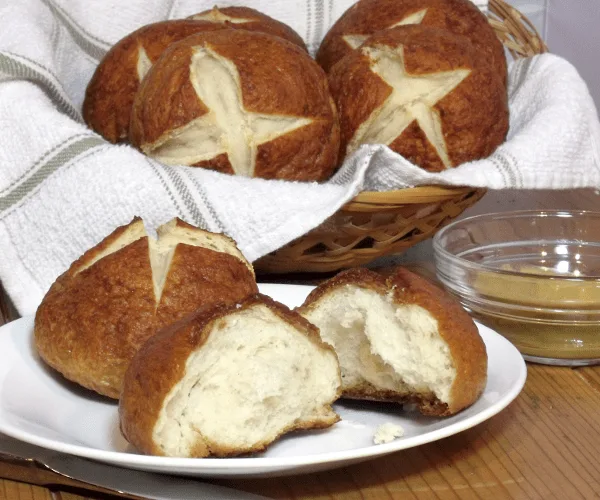
A Pretzel Roll?
I had never eaten a pretzel roll until I found my way to Wisconsin.
It showed up on my plate, encasing big, juicy burger. A bun that tasted like a pretzel and looked, well, slightly pretzel-ish.
Upon my questioning, every native Wisconsinite around me was astonished that I had never seen, much less heard of, a pretzel roll.
And let me tell you, after that first, delicious pretzel roll experience, I haven’t stopped craving that dense, chewy dough and beautifully browned, salty crust.
We had the opportunity to introduce my family to the delicious wonder that is a pretzel in roll form one time when they came to visit.
Their response was similar to my own.
“And… here we have, some kind of… roll?” Followed soon by, “What!? They’re really good,” as my brother helped himself to another.
Tim and I just smiled.
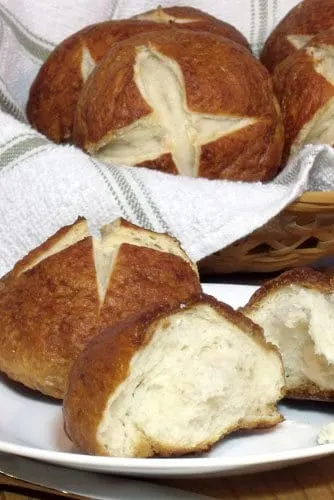
Laugenbroetchen: A pretzel in roll form
Laugenbroetchen literally translates to lye roll, and while that may seem unappealing at first, we have to realize that all pretzels are poached in a lye solution before baking.
It’s what gives them their characteristic crust and chewy texture.
(To be clear, we’re talking about food-grade lye here, not the kind of lye that you may use as an oven cleaner. Please don’t attempt to use that lye to poach your next batch of pretzels.)
The lye does coats the dough with a high pH (alkaline) solution, which, when baked, creates that nice browning effect. The higher the pH the darker the crust will be.
But, thankfully, lye isn’t the only way to achieve that characteristic brown pretzel crust.
Baking soda has a much weaker pH, but, as you can see, still gives a nice brown crust.
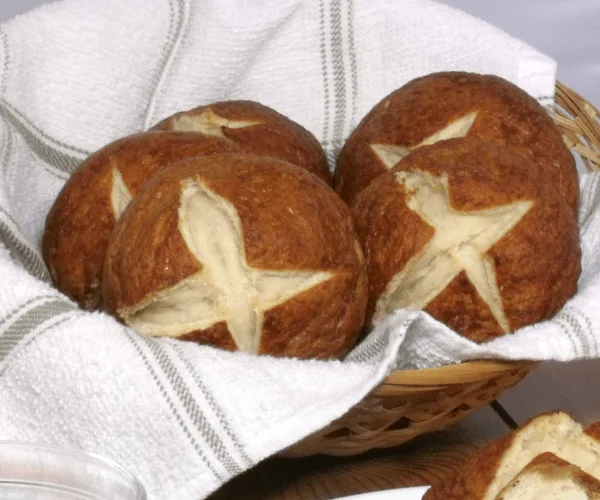
Making Soft Pretzels as Rolls
Soft pretzels really aren’t difficult to make, but they do require a bit of attention for the poaching of the dough.
Don’t be discouraged if your first attempt doesn’t turn out the way you hoped.
They can be a bit nuanced, and we have found that things like this are always simpler the second time around.
The roll form is a bit easier than your classic twisted soft pretzel though, since you don’t have to worry about shaping and keeping the perfect pretzel form.
That in mind, if you’ve never made soft pretzels before, I would recommend starting out making pretzel rolls, just to get your hands into the dough and to try out the poaching process.
Laugenbroetchen (German Pretzel Rolls)
Ingredients
For The Dough
- 3 c unbleached all-purpose flour
- 2 1/4 tsp active dry yeast (1 packet)
- 1 1/2 tsp salt
- 1 1/2 tsp sugar
- 1 c water, warmed to 105F
To Poach The Pretzels
- 8 cups water
- 1/4 c baking soda
- Coarse salt
Instructions
- In a large bowl, mix together flour, yeast, salt, and sugar.
- Make a well in the middle of the dry ingredients, and add warm water and mix well, until the dough comes together. (Add more water, 1 Tbsp at a time, if necessary to create a smooth dough.)
- Turn dough onto a lightly floured surface and knead 7-10 minutes, until the dough becomes smooth and elastic. (Alternately, mix 2-3 minutes using the dough hook of a stand mixer. Or, use your bread machine's dough setting, following the manufacturer's instructions and picking up this recipe again at step 5.)
- Place dough in a greased bowl, cover with a damp towel, and let rise until doubled, about 45 minutes.
- When dough has doubled, punch in down and knead a few times. Divide the dough into 12 even pieces. Roll each piece into a ball. Place balls onto a well-greased sheet of parchment or wax paper, about 2 inches apart. Cover loosely with a damp towel and let rise until puffy and nearly doubled- 20-30 min.
- Ten minutes into the dough's rising time, start the 8 cups of water boiling in a 3-4 quart pot and preheat the oven to 450F.
- Once dough has doubled, add the baking soda to the boiling water. (Do this carefully, as the baking soda will fizz up considerably.)
- Adjust heat so that the water barely maintains a gentle simmer. (You want tiny bubbles to give your dough a smooth crust, big bubbles will beat up your dough and result in a mottled-looking crust.)
- Carefully, so you don't deflate the risen dough, add a few rolls to the water at a time, making sure there is enough room in the pot that they do not touch.
- Poach dough 30 seconds on each side. (It is important not to over-poach the rolls, or they won't continue to rise in the oven. During the poaching, you just want to create a nice film on the outside of the rolls.)
- Remove dough from the water with a large slotted spoon. Let as much water drain back into the pot before placing the rolls onto a greased baking sheet. Repeat with remaining dough.
- Once all rolls have been poached, gently cut a deep X into the top of each roll using a serrated knife. Sprinkle with coarse salt.
- Place rolls into the oven and bake 14-15 minutes, until nicely browned.
- Let rolls cool on a wire rack.
Notes
If you liked this recipe, here are some similar dishes you may enjoy!

Sarah founded Curious in 2010 as a way to save her recipe creations and share culinary experiences. Her love for cultural cuisines was instilled early by her French Canadian Grandmother. Her experience in the kitchen and in recipe development comes from over 10 years working in professional kitchens. She has traveled extensively and enjoys bringing the flavors of her travels back to create easy-to-make recipes.
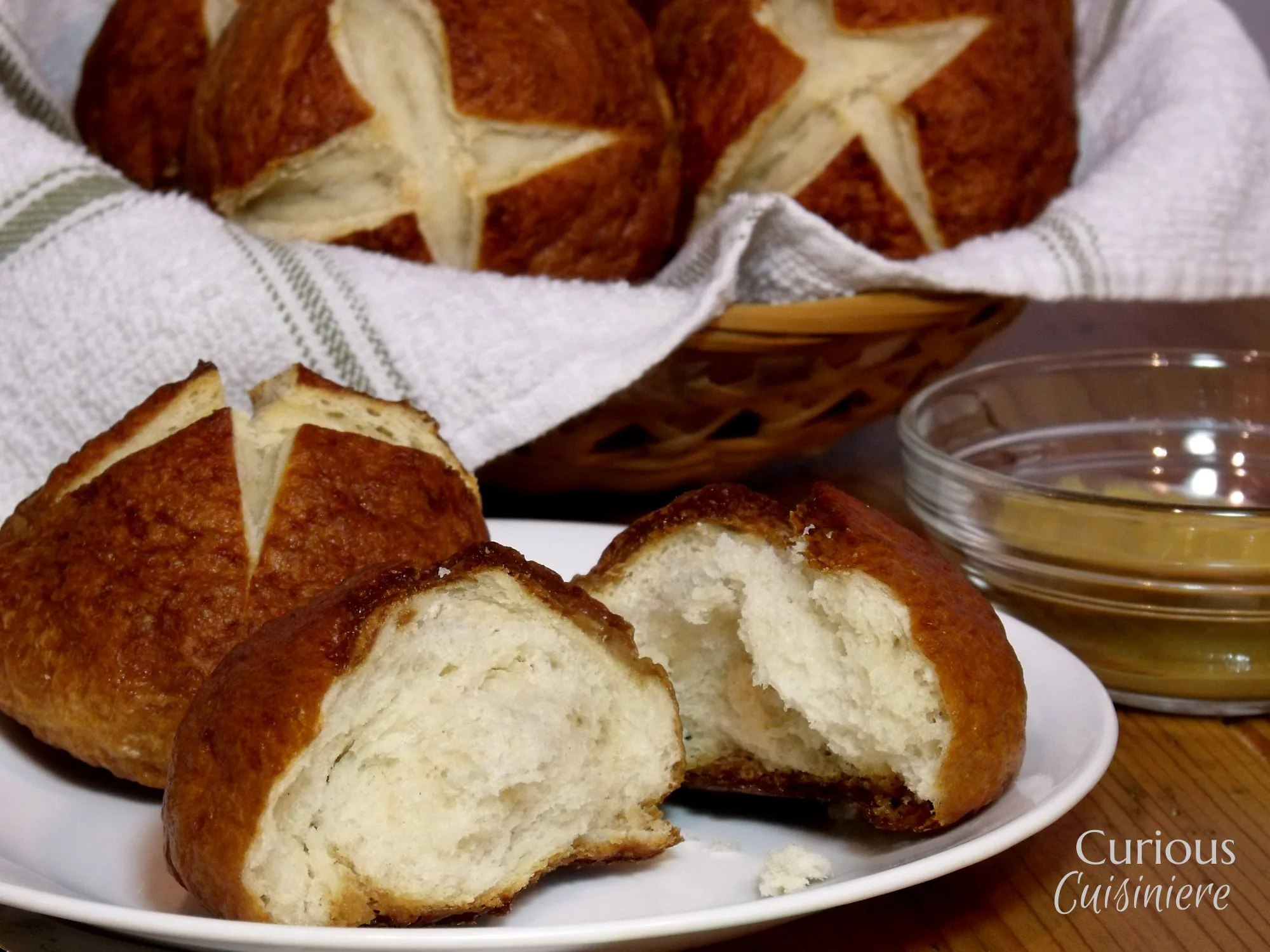


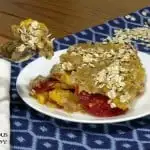





Gary
Tuesday 30th of April 2024
I don't see mention of using an egg wash but there is a comment below referencing it. Should it be used or has it been omitted?
Sarah - Curious Cuisiniere
Monday 6th of May 2024
Hi Gary. I believe we initially had you use an egg wash, but found in subsequent testing that the rolls browned well without the extra step. If you like the color or texture of an egg wash, you are welcome to add it.
Dom Cammarata
Wednesday 30th of November 2022
The rolls turned out great, delicious, but were quite hard after one day, unlike the ones I buy from Lidl that are soft for a few days. Any recommendations? Thanks, Dom Cammarata
Sarah - Curious Cuisiniere
Thursday 1st of December 2022
Hi Dom. Glad you enjoyed them. How did you store them? We store ours in an air-tight container or Zip-lock bag. You could possibly dial back the baking time a bit, possibly your oven runs a bit hot. Or maybe you didn't add quite enough water to the dough? It is hard to say without watching you make them. But I will say that when we make these (and they are a favorite in our house) they do stay soft for a few days.
Hannah Ramadan
Thursday 7th of January 2021
My boyfriend is from Germany and I wanted to make him something that reminded him of home. He said these taste EXACTLY like authentic german rolls should and are one of the bests he's had. Thanks for the recipe!
Sarah Ozimek
Friday 8th of January 2021
So glad!! Thanks for sharing!
Matthew
Monday 2nd of July 2018
Nice article. Laugenbrotchen are a standard item in German bakeries, and are very similar, in makeup to soft pretzels, just in a larger format.
To clarify, "Laugen" does not mean "lye" per se, it just means "alkaline", which is anything with a high pH (if you remember your high school chemistry). In this case the alkali comes from baking soda, not from lye. In case you're wondering, lye is the common name for sodium or potassium hydroxide - which also is non-toxic if diluted enough - but its better known for making soap than for baking!
Sarah Ozimek
Tuesday 3rd of July 2018
Thanks for your clarifications Matthew!
Jeff
Monday 11th of June 2018
i’ve no way of sharing photos but the rolls came out ..( picks one up ..it’s still warm ...) takes a bite ... oh my . i didn’t have coarse salt so i used standard / regular table salt and it is Soooo very yummy. crisp outside soft chewy center and tastes just like a soft pretzel! delicious ! thank you :)
Sarah Ozimek
Tuesday 12th of June 2018
We're so glad you're enjoying the pretzel rolls. These are definitely one of our favorites, and now we're craving some!